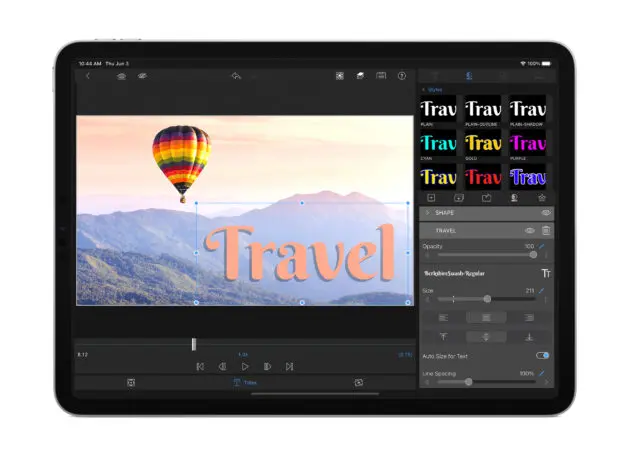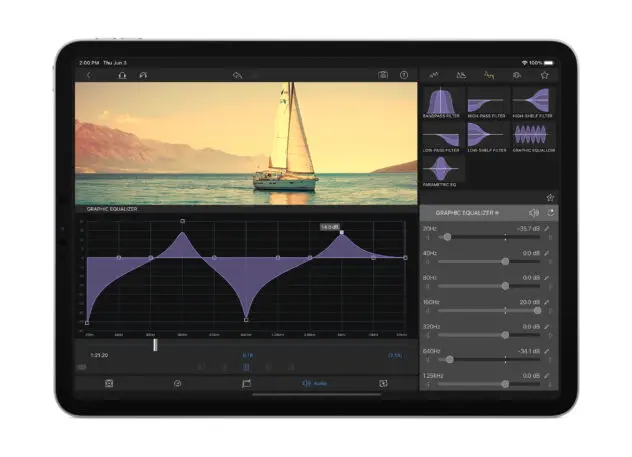For the past five years, the video-editing app LumaFusion has been a poster child for iPad productivity.
While the iPad has always been usable for more than just content consumption, video editing is exactly the kind of creative task that Apple loves to champion. LumaFusion, which was created by former product developers from Avid and Pinnacle, two of the longest-established names in video editing, shows that the iPad can rival a laptop or desktop computer in handling complex editing jobs.
It wasn’t a huge shock, then, when Apple named LumaFusion its iPad App of the Year in early December. LumaTouch, the 18-person development team behind LumaFusion, says that the app’s usage has soared during the pandemic—it now has 930,000 users. And it delivered a meaty update this year with support for external hard drives and a more customizable interface. While Apple’s own iMovie app might be sufficient for basic video editing, LumaFusion is a professional-grade tool, supporting more video and audio tracks, complex transitions, and track-based editing similar to Adobe Premiere.
Amid rumors that Apple may eventually bring its own Final Cut Pro software to the iPad, LumaTouch can’t assume that its spot atop the iPad video editing heap will be secure forever. But at least for now, cofounders Terri Morgan and Chris Demiris say they’re living the dream by creating the product they’ve long envisioned.
Borne from acquisitions and layoffs
LumaFusion might never have existed if Avid hadn’t dipped its toes into the mobile app business a decade ago.

Avid was never quite sure what to do with the resulting product. Demiris believes it could have been a companion to Avid’s pro-editing solutions, allowing filmmakers to experiment with lightweight edits on the fly, but Avid didn’t see it that way.
“It frankly scared Avid, because here we had this $30 product, and they couldn’t figure out how it would fit into their whole ecosystem of [expensive video editing] systems,” he says.
Venerable software company Corel acquired Avid’s consumer video business in 2012. It turned out to be equally unenthusiastic about the iPad app, says Morgan. She recalls an executive describing the iPad version as “an iceberg, and they were going to let it melt,” which she quickly realized was a precursor to being laid off.
“Corel is a company that buys technology companies and continues their products, but with as little development cost as possible,” Morgan says. (Asked about this criticism, a Corel spokesperson says that the company has changed a lot since 2012 and that it’s pursuing a new strategy under CEO Christa Quarles, who joined the firm in September 2020.)
Still, Morgan and Demiris, who had left the company shortly before the layoffs, loved working on the iPad app, which Corel had renamed Pinnacle Studio. They convinced Corel to maintain it with them as contractors, and in the meantime, they started planning a new app of their own.

LumaFusion—the name is a reference to light and the fusing of multiple video layers—was finally ready in mid-2016. Morgan says she and Demiris offered Corel an opportunity to purchase the new app and keep them on board as developers, but the company wasn’t interested, so they stopped working on Pinnacle Studio and launched their new app that December. (Pinnacle Studio remains available in the App Store, but it hasn’t seen an update since 2016 and now has an average rating of 2.7 stars.)
The initial launch period was tough. Apple was still trying to establish the iPad as more than just a content consumption device—the first Pro models had only launched a year earlier—and LumaFusion had arrived with little fanfare. But Morgan credits a June 2017 article by 9to5Mac’s Jeff Benjamin as a breakthrough. The piece heaped praise on LumaFusion for succeeding where other iPad video editors had failed, and for showing what the iPad was capable of accomplishing.
“Since the six months after we released it, it’s been upward trajectory,” Morgan says.
No subscriptions necessary
Despite its success so far, LumaTouch hasn’t been tempted to change its business model. The company charges $30 for LumaFusion—it raised the price from $20 for new customers after a major update in 2019—which is on the pricy side for an iPad app, but is much cheaper than desktop video editors. (Final Cut Pro costs $300, and Adobe Premiere Pro costs $240 per year.)
The up-front price is the main way that LumaTouch monetizes the app, though it also offers in-app purchases for Frame.io integration and Final Cut Pro file exports, which it considers niche features. Its sole subscription feature is an optional library of stock footage.
Morgan says LumaTouch hasn’t been tempted to adopt a subscription model for the core app, even as other productivity app makers have embraced them as a way to both draw in new users and fund future app development on a steady basis. She believes that even with up-front pricing, LumaTouch can be a sustainable business well into the future.
“It’s an ethical way of selling, I believe,” she explains. “We make something, we love it, we put a price on it, and then you buy it, and you can love it. That’s the whole contract right there.”

But Morgan believes a subscription model can put undue pressure on developers to release new features on a regular basis, even if they’re unnecessary or unhelpful. She also believes a one-time purchase makes more sense for consumer video editing, which isn’t a constant need for all users.
“If you only edit, say, twice a year, and you have to pay a monthly subscription for that editing product, it’s just going to lead to you feeling guilty about having spent money [for something you] didn’t use,” she says.
The Final Cut threat
Despite its success, LumaTouch has been bracing itself for direct competition from Apple. In April 2020, Jon Prosser of FrontPageTech wrote on Twitter that he was “100% confident” that Apple would release iPad versions of Final Cut Pro, the audio editor Logic Pro, and the app development tool Xcode. Another rumor last April from LeaksApplePro claimed that Apple would announce all three at its WWDC event.
None of those reports have panned out, but Demiris says he’d be surprised if Apple wasn’t working on something more advanced than its current iPad iMovie software, which is less capable than its Mac counterpart.
Still, he believes LumaFusion will always have differentiators. For instance, lets users choose between either a Final Cut-style magnetic timeline or track-based editing akin to Premiere Pro. It also integrates with storage solutions from Gnarbox and WD, and it recently launched a tie-in with Dropbox’s Replay feature for collaborative editing. Apple is unlikely to offer such a variety of options: “That’s always been an Apple thing: If you do it Apple’s way, it works really well, but if you want to do something a little different, it doesn’t,” says Demiris. (An Android version of LumaFusion is also in early development.)
LumaTouch has also withstood competition before. The company was initially concerned, Demiris says, when Adobe launched a mobile version of its Premiere software for the iPad in 2018. But that turned out to be a much more limited app than the desktop version of Premiere Pro and has only led to greater interest in LumaFusion.

“LumaFusion steps back into the process, and allows people to bring editing closer to the story,” she says. “It’s just an age-old wish, and I finally feel like you can really actually do that.”
Recognize your brand’s excellence by applying to this year’s Brands That Matter Awards before the early-rate deadline, May 3.
